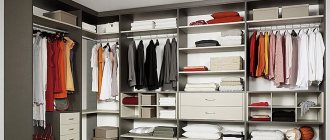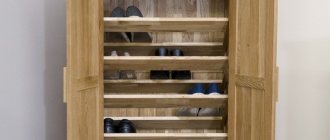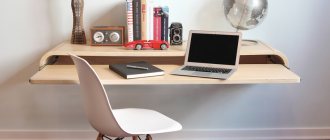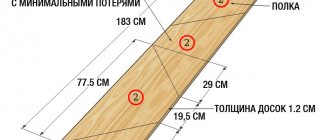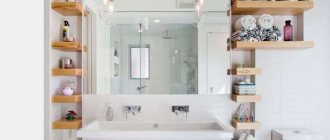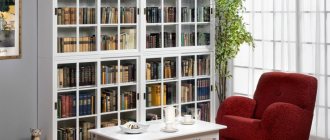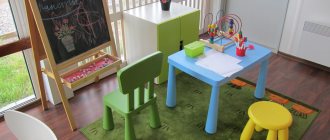The pantry in a house or apartment should be rationally arranged. This is a separate room that is used to store various things and non-perishable food products. In most cases, the pantry contains a huge number of items that clutter the entire room.
A storage room is a separate room in an apartment or house, and its arrangement should be rational.
To avoid this, use racks and shelves in the pantry. They help to properly organize your storage system and avoid clutter. Next we will talk about how to make simple shelves for your pantry with your own hands.
To avoid clutter, you can put shelving in this room.
Features of shelving in the pantry
The rack is represented by a structure that consists of open shelves. A reliable and strong case is used to frame them. The main feature of this type of furniture is its large capacity with small size and shape. The pantry shelving option showcases a simple design. In most cases, they are entrusted with only the function of correctly placing all things.
Racks are a structure consisting primarily of open shelves framed by a strong and reliable frame.
Shelves in the pantry can have glass and pull-out components. This solution helps to properly organize the storage of different types of things. There are also models with or without a back wall. Very often they are similar to kitchen units, but have a simpler appearance. In this case, the color of the material may be different, since this parameter completely depends on the preferences of the property owners.
With a small space occupied, the rack allows you to accommodate a lot of things, freeing up the visible space of the apartment from them.
How to make a metal rack with your own hands
Before you start manufacturing, you need to imagine what such a structure will look like and what fasteners will be used.
Rack drawing
Next, take the necessary measurements and draw your idea on paper. It is possible to find a suitable drawing and assembly diagram on the Internet or draw it yourself. The design can be of any size and shape that will fit into a given pantry.
For fastening, it is better to choose metal fasteners, as they are very durable and can withstand any weight.
Necessary materials
When starting to select a material (metal, wood, plastic) for manufacturing and fastening materials, you need to know what will be stored on them, the expected weight, dimensions.
For the frame you should take a metal corner or pipes.
In addition, you will need connecting elements for assembling the frame, brackets, screws and self-tapping screws.
For manufacturing, you need to select a material, the thickness of which depends on the expected weight of the luggage (the greater the weight, the thicker the shelf fabric).
Tools
For assembly you will need the following tools:
- pencil;
- drill;
- screwdriver;
- building level;
- hacksaw for metal;
- roulette.
When starting assembly, it is better to wear special clothing so as not to get dirty or get injured.
Types of shelf designs
The main classification of furniture is based on design features. In the store you can find three varieties - linear, U-shaped and corner racks. Proper arrangement of space depends on the dimensions of the pantry.
INTERESTING! Most often, when choosing a shelf, the guidelines are the features of the room. Shelving should fit into the room and create proper organization of the storage system.
At the same time, you can separate types of products according to the dimensions of the shelf and the rack itself. Various manufacturers provide their products to suit customer needs, for example, equipped with closed drawers and doors. They are performed similarly with display cabinets.
A distinctive feature of such furniture is its spaciousness with relatively compact forms.
Modern designs can also be equipped with compartments for jars, a glass facade, shelves with baskets, compartments with metal fasteners for bottles, and drawers for vegetables.
Such options are selected on a case-by-case basis to suit the needs of property owners.
Rack design and equipment
The rack has a simple design:
- racks (their number is determined taking into account potential loads);
- jumpers;
- shelves.
There are models with and without a back wall.
Planks, racks and thrust bearings form the frame of the system. It is responsible for the stability and safety of the geometry of the structure, regardless of its height or width.
It is very convenient when plastic covers are attached to metal racks . Such elements are needed not only for the legs (thrust bearings), but also for the freely protruding ends of the profile. They will prevent damage to the floor and protect your hands from scratches when you search for something on the shelves.
Sometimes the racks are fixed to the wall using metal corners.
This increases the stability of the system. Optionally, modern shelving designs can be equipped with equipment such as:
- drawers;
- holders for cans of different sizes;
- closed display cases;
- roll-out baskets for storing vegetables and fruits;
- compartments for placing wine, seasonings;
- shelves for various small items;
- compartment for work clothes;
- compartment for mop and vacuum cleaner.
A display rack is an excellent solution for storing valuable items. Glass will protect the contents of the shelves from dirt and dust. This piece of furniture differs from a display cabinet in the small number of closed shelves.
Important points when designing utility shelves
You can also make shelving and shelves for your pantry yourself. To do this, there is no need to have specialized knowledge and skills. First of all, a sketch of the furniture set is created, which takes into account all the important parameters.
The pantry rack is a convenient storage for food, dishes, and homemade preserves.
The diagram must reflect:
- room size;
- shelf dimensions (height, width, material thickness);
- design features.
Each shelf of such a rack is used to the maximum and allows you to easily find the desired item, saving time on searching.
All these parameters affect the final appearance and correct installation. In order not to miss a single detail, we recommend that you familiarize yourself with the information on how shelves for the utility room are made by hand.
Choosing a place for a shelf
When thinking about how to make shelves in your pantry, it is important to decide on the location. The place where the shelves will be attached should be chosen taking into account many factors.
The wall on which it is planned to mount must be load-bearing.
This is the key to the strength and durability of the structure. A thin interior partition may not withstand the load and shelves filled with heavy objects will collapse.
In addition to boards, you can use particle boards, plywood and other suitable materials.
If the fastening is not carried out directly to the wall, then you can use your imagination in accordance with the desired shape of the location.
Consider the dimensions of the items you intend to store.
It is important to prepare the storage room itself, level and tidy up the walls in advance so that the shelves stand up straight and there is no need to adjust them to the topography of the wall.
It is worth taking care of lighting before the installation of the rack occurs.
How to make shelves in your pantry with your own hands
Before proceeding with the main actions, it is necessary to determine the design of the structure, shape, and method of attaching the shelves to the wall. All these manipulations relate to preparatory actions.
Preparatory activities
First of all, the rack is depicted on paper. In this way, future furniture will be visualized taking into account the size and wishes for the storage system for household items.
The box can be open on both sides or have a back wall.
What to make shelves from
The main materials for making shelving are steel and wood. These components are characterized by the reliability and durability of the frame. But the only drawback is the lack of resistance to moisture and steam.
Metal or wooden frames withstand mechanical stress and heavy loads.
Rack shelves can also be made from various raw materials. For example, they use wood, metal, including galvanized metal, MDF, glass, and chipboard profiles. All the options mentioned have their advantages and disadvantages. They must be taken into account when choosing material for making your own storage system for the pantry.
Despite the wide range of materials used in the production of pantry racks, only the most reliable ones remain a priority.
Required materials and tools
To properly make shelves in the pantry, you need to prepare the following tools:
- electric jigsaw or regular hand saw;
- hammer;
- a measuring device, such as a tape measure;
- screwdriver. Two types of profile may be required - linear and cruciform;
- fasteners (screws or nails);
- screwdriver
Other tools may be required during production.
The set depends entirely on the master’s preferences in working materials, method of fastening the shelves and frame.
Manufacturing options
The principle of manufacturing a storage system is entirely based on the mass of materials that have been selected for the process. The location is also selected based on this factor.
Wall shelves
Lighter structures can be installed with fixation to the wall. In most cases, wood and metal are used, which are connected to the wall using special fasteners, for example, hidden shelf supports, decorative brackets, hangers or hanging ears.
Such structures are considered hinged.
Wall shelves do not require labor-intensive manufacturing; it is necessary to properly prepare and process the material. After sanding and painting, you can begin installation.
Installation is carried out according to a pre-planned scheme to avoid errors and inaccuracies.
Rack
Massive frames that are designed for heavy loads are preferably placed on the floor. Such structures can be fixed to the wall surface or in the form of stationary furniture. It all depends on the intensity of use of the rack and shelves. Such storage systems can be represented by a simple structure made of chipboard and wood.
If necessary, the rack can be painted: this helps extend the service life of the material and allows the product to look most harmonious in a small space.
The production of a rack most often begins with the arrangement of the frame. Subsequently, the craftsmen fill it with the necessary components in the form of shelves, drawers with or without doors. In the process of performing actions, it is important to choose the right fasteners, as this solution will help minimize the risk of damage to the structure and its integrity. This approach is important, because very often racks are used to store fragile household items (cans, bottles, dishes).
All models are united by the fact that they are selected based on the specific footage of the pantry.
Necessary materials
When deciding how to make shelves in a pantry, you need to decide on the material from which the structure will be made. There are several options.
- The budget option allows you to make shelves from the material included in the furniture. If you have an old wall or an unnecessary chest of drawers, then you can disassemble them and get a fairly durable and, at the same time, free canvas for making boards.
This will be enough to ensure that the pantry has good and reliable shelves on which you can store anything. - The second option involves purchasing material for shelves in the pantry. The choice must correspond to the list of intended items for storage, their dimensions, and weight.
It is advisable to make a rack directly in the pantry, since if it is large, then it will be difficult for you to bring it inside.If it is expected that the racks will be loaded with conservation, then a solid board about 30 mm wide will be the best choice.
Any boards will do - the main thing is that they are of sufficient length and can withstand the expected load.
In addition to wooden materials, you can choose others, the main thing is durability and the possibility of self-assembly. In addition to the shelves, you should stock up on the fasteners on which the shelves will be installed, and the consumables necessary for the work.
In order to make wooden shelving for a pantry, you will not need a lot of materials and serious tools.
Simple tips for creating shelves in your pantry
Equipping a pantry is not difficult. But this process requires compliance with some rules and recommendations:
- correct measurement of the room and drawing a dimensional grid on the walls;
- correct selection of material for shelves and frames, taking into account the intensity of use;
- The choice of fasteners depends entirely on the level of load on the rack.
These three basic tips allow you to take an optimal and responsible approach to creating a storage system from scratch with your own hands.
Shelves and racks in the pantry are a simple, but practical and multifunctional design. It allows you to properly organize the storage of household items and various food products. Today, everyone can buy finished products or make them themselves. In the latter option, the information offered above will help.
The convenience of such structures is the ability to use the usable area with maximum benefit.
DIY shelf options: step-by-step instructions
You can save your family budget with the help of homemade shelves for your pantry and detailed master classes, which are given below.
How to make a wooden shelving unit for a pantry?
Before starting work, you need to measure the walls of the pantry and create a drawing of the desired structure. Next, prepare in advance the consumables necessary for the manufacture of functional shelves.
The photo shows a linear homemade wood shelving unit that occupies the entire wall of the pantry.
Tools and materials
To work you will need:
- Planed timber for a vertical stand (8 pieces, about 2 m).
- Bar for horizontal supports (12 pieces, about 50 cm, depending on the depth of the rack).
- Boards or lining for shelves (the quantity depends on the depth of the shelves, the length depends on the length of the wall).
- 16 metal corner fasteners (corners).
- 45 screws (3.5x25).
- About 70 thin carnations.
- Wood impregnation and brush.
- Building level.
- Roulette.
- Hammer.
- Jigsaw.
- Screwdriver.
Step-by-step instruction
- First you need to prepare the material. Using a hacksaw or jigsaw, we cut the bars and lining in accordance with the dimensions of the future pantry rack.
- We apply impregnation, carefully processing every detail. You need to dry for as long as indicated in the instructions on the can.
- We fix the corners with screws at the level where the shelves will be located:
- We fix the horizontal bars as follows (you should get 4 such structures):
- We install the lining horizontally, nail it with thin nails:
- We make the second shelf in the same way: screw the corners, fix the horizontal bars, attach the lining.
- We lay the upper horizontal bars and fasten them.
- The pantry shelves are ready. In this way you can make a rack of any height, depth and shape.
You can learn more about how to make shelves in a pantry from this video:
DIY wall shelves
The following describes the easiest and most economical way to make wall shelves in a small pantry. The amount of material for shelves depends on the size of the room and the number of floors.
The photo shows pantries in small apartments such as Khrushchev or Leningrad, equipped with simple shelves.
Tools and materials
To make shelves for your pantry with your own hands, you will need:
- Planed bars.
- Plywood, chipboard, boards or remains of old furniture.
- Self-tapping screws for fastening.
- Screwdriver.
- Thin nails.
- Hammer.
- Level.
- Jigsaw or hacksaw.
Step-by-step instruction
- We cut the timber and plywood in accordance with the area of the pantry. If desired, they can be painted or varnished. For the frame of one shelf you will need 1 long and 2 short bars, for the base - a plywood sheet or boards of the required size and thickness. We make markings on the walls and securely screw the bars.
- We make markings for the next shelf.
- We install a shelf in the pantry.
- We secure it with nails.
And this video talks about installing a wall shelf in a closet in two ways: using brackets for laminated chipboards and using standard brackets.
Shelves in the pantry from a profile
A good U-shaped shelving unit for a spacious pantry is made from metal profiles. Having understood the principle of operation, you can make shelves of any configuration, replace plywood with wood, paint the metal profile and create a shelving unit in the loft style.
The photo shows two types of shelves for the pantry, created with your own hands from metal profiles and wood.
Tools and materials
- Guide profiles 50x40.
- Guide profiles 50x50.
- Plywood or wooden boards.
- Roulette.
- Building level.
- Metal scissors.
- Jigsaw.
- Screwdriver.
- Dowel-nails.
- Self-tapping screws.
- Ladder.
Step-by-step instruction
- We make a drawing and calculate the amount of materials. We cut the profile into components according to size.
- Mark horizontal lines. We attach 50x40 guide profiles to the walls using dowel nails.
- We make the frame of the first shelf, put it on temporary supports from the profile.
- Cutting a sheet of plywood with a jigsaw:
- We secure the finished parts with self-tapping screws.
- We replace the temporary stands with guides. The shelves for the walls in the pantry are ready.
This video clearly shows how to make shelves in a pantry from a profile yourself:
Materials for making shelves and racks
So, what materials are desirable to use in the manufacture of shelves and racks? To do this, you should consider what a particular shelf is intended for.
So, for example, if something heavy will be stored on the shelf, such as cans with twists, or equipment, or parts, then a metal or wooden structure is needed. They have sufficient strength and a long service life, and due to the fact that the shelves have good stability, they can also be used for storing various building materials. But in this case, it is necessary to install stiffeners in the structure.
There is also an analogue - plastic structures that are light in weight, but they are no less durable. They also do not need special treatment: plastic does not rust or mold, and is easy to clean from dirt.
Shelves made of wood have good strength, but you need to correctly determine the thickness of the board and the location of the fastenings. And the best material for a wooden rack is larch or pine, since it is easy to process. No special tools are required to work with such material, and those that are needed are usually easily accessible and available to everyone.
Path Included
In order to store lighter supplies, such as dishes or books, or collectibles, you can use glass, plywood, or MDF. Bounding edges should be added to the shelves so as not to accidentally break fragile objects or spill loose ones.
However, we did not consider all materials, but only those that are most common. Something that is always easy to get. So, for example, meter-long boards can be removed from a wooden pallet, which are usually used on construction sites and are thrown away by builders as garbage. Or plastic vegetable boxes, or old unnecessary furniture.
However, in order for everything planned to be successful, you need to think through everything down to the smallest detail: from the layout of the pantry right down to the number of fastenings for each shelf.
Few square meters
It is impossible to say exactly how much space a storage room should occupy in an apartment. There cannot be an optimal solution here - everything is individual. We can only say with confidence that even the smallest meter-long pantry will allow you to remove out of sight a significant part of what is not used daily, but must be stored somewhere. Such items include cleaning products, sports equipment, seasonal clothing, work tools, pet carriers, suitcases, and so on.
Valerii_Honcharuk/Depositphotos
“Ideally, the minimum area for a functional storage room should be about 2.5 square meters. m, but it is clear that such luxury is not available to everyone. In addition, if this is a dedicated niche along a selected wall (or a series of niches in a passage corridor), the area can be reduced to 1 square meter. m. Many often refuse a full-fledged pantry in favor of a balcony. This is also a working option, and, of course, it is possible to properly organize the storage of things there, however, for this it will be necessary to install shelving, open and closed shelves and cabinets. Without this, the balcony can simply turn into a warehouse on which assorted things are piled up,” adds Valeria Kuznetsova.
Madhourses/Depositphotos
